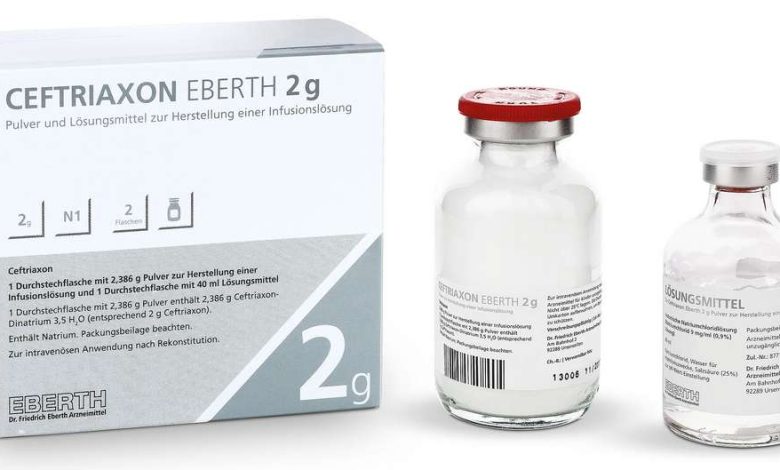Ceftriaxone: instructions for using the medicine, structure, Contraindications

When ATH: J01DD04
Title: Ceftriaxone (Ceftriaxone)
Ceftriaxone: characteristic
Cephalosporin antibiotic III generation for parenteral use.
Ceftriaxone sodium - crystalline powder of white to yellowish-orange, easily soluble in water, sparingly in methanol, very little — in ethanol. pH 1% aqueous solution is about 6,7. The color of the solution varies from light yellow to amber and depends on the length of storage, and the concentration of the solvent. Molecular weight 661,61.
Ceftriaxone: pharmachologic effect
Broad-spectrum antibacterial, bactericide.
Ceftriaxone: application
Bacterial infections, caused by susceptible microorganisms: abdominal infections, incl. peritonitis, GI, Biliary (incl. kholangit, gallbladder empyema), infections of the upper and lower respiratory tract and ENT (incl. acute and chronic bronchitis, pneumonia, lung abscess, empyema), epiglottiditis, bone and joint infections, skin and soft tissue, infections of the genitourinary system (incl. pyelitis, acute and chronic pyelonephritis, cystitis, prostatitis, epididymitis), infected wounds and burns, infections of the maxillofacial region, neoslojnennaya gonorrhea, incl. caused by microorganisms, allocating penicillinase, sepsis and septicemia bakterialynaya, bacterial meningitis and endocarditis, chancroid and syphilis, Lyme disease (Lyme borreliosis), typhoid fever, salmonellosis salmonellonositelstvo, infections in immunocompromised patients, prevention of postoperative infectious complications.
Ceftriaxone: Contraindications
Hypersensitivity, incl. to other cephalosporins.
Ceftriaxone: restrictions on use
Renal and / or hepatic insufficiency, digestive diseases in history, particularly ulcerative colitis, эnterit or colitis, associated with the use of antimicrobials; hyperbilirubinemia in neonates, premature babies.
Ceftriaxone: use during pregnancy and lactation
When pregnancy is possible, if the effect of therapy outweighs the potential harm to the fetus.
Category actions result in FDA - B. (The study of reproduction in animals revealed no risk of adverse effects on the fetus, and adequate and well-controlled studies in pregnant women have not done.)
At the time of treatment should stop breastfeeding (It passes into breast milk).
Ceftriaxone: side effects
From the nervous system and sensory organs: <1% - Headache, dizziness; <0,1% - Seizures.
Cardio-vascular system and blood (hematopoiesis, hemostasis): eozinofilija (6%), thrombocytosis (5,1%), leukopenia (2,1%); <1% - Anemia, incl. gemoliticheskaya anemia, neutropenia, lymphopenia, thrombocytopenia, Elongation PV; <0,1% -reduce PV, heartbeat, nose bleed, agranulocytosis, leukocytosis, Lymphocytosis, monocytic, ʙazofilija.
From the digestive tract: diarrhea (2,7%); <1% - Nausea or vomiting, dysgeusia,
flatulence; <0,1% -abdominal pain, psevdomembranoznыy colitis, dyspepsia, transient increase in transaminases (AST — 3,1%, ALT- 3,3%); <1% - Raising the level of alkaline phosphatase or bilirubin; <0,1% - Jaundice, bile stasis ("Sludge") or psevdolitiaz (epigastric pain, anorexia, nausea and vomiting).
With the genitourinary system: increase in blood urea nitrogen (1,2%); <1% -increase of creatinine and the presence of cylinders in urine; <0,1% - Gematuriya, glycosuria.
Allergic reactions: rash (1,7%); <1% -itching, fever or chills; <0,1% -Anaphylaxis, bronchospasm, serum sickness, hypersensitivity pneumonitis.
Other: <1% -candidiasis, vaginitis, profuse sweating, flushing. Local reactions: pain, infiltration, sensitivity at the injection site (1%), thrombophlebitis after the on / in the (<1%).
Ceftriaxone: drug interaction
Strengthens (mutually) effect of aminoglycosides against many Gram-negative microorganisms. NSAIDs and other inhibitors of platelet aggregation increases the likelihood of bleeding, petleve dioretiki and nefrotoksicnae drugs — violations of the kidneys. Do not interact with probenecid. Pharmaceutical incompatible with other antimicrobial agents. Incompatible with ethanol.
Ceftriaxone: overdose
Treatment: simptomaticheskaya therapy. No specific antidote. Hemodialysis and peritoneal dialysis are ineffective.
Ceftriaxone: Dosing and Administration
/ M and I /; adults and children over 12 years 1-2, 2011 1 once a day, if necessary - up 4 g (preferably 2 administration via 12 no). The duration of treatment depends on the type and severity of the infection. After the disappearance of symptoms and normalization of temperature, it is recommended to continue to use at least three days. In uncomplicated gonoree give/m 0,25 g once. For newborns up 2 weeks dose of 20-50 mg/kg/day, for children 3 Sun to 12 years — 20-80 mg/kg/day, in 2 introduction. The daily dose should not exceed 2 g, in preterm infants is 50 mg / kg, Prevention of postoperative infections — 1 g once for 1/2-2 hours before the operation. In/in in the form of infusions for 15-30 min at a concentration of 10-40 mg/ml.
For in / bolus drug is dissolved in sterile water for injection at a ratio of 1:10, for the/m introduction-in 1% lidocaine (0,5 g powder 2 ml or 1 -in 3,5 ml).
Ceftriaxone: precautions
When combined renal and liver failure requires correction of the dose and monitor plasma concentration (content in the blood is recommended to periodically monitor and isolated human liver or kidney).
Patients, with hypersensitivity to penicillins, possible cross-allergic reaction cephalosporin antibiotic.
In the case of long-term administration is required to perform cytology Blood. Keep in mind the possibility of dysbiosis, superinfekcii.
To use caution in newborns with hyperbilirubinemia, in preterm infants and patients, prone to allergic reactions.
In patients with impaired synthesis or declining stocks of vitamin k (such as chronic liver disease, malnutrition) It requires the definition of PV. In the case of elongation PV before or during therapy requires vitamin k.
There are reports of changes detected by ultrasonography in patients with gall bladder, treated with ceftriaxone (changes are transient and disappear after discontinuation of treatment), some of these patients were also observed symptoms of gallbladder. If signs of gallbladder disease and / or ultrasound abnormalities treatment with ceftriaxone should be discontinued.
Interactions of Ceftriaxone with other drugs
| Active substance | Description of interaction |
| Ethacrynic acid | FMR. Strengthens (mutually) the likelihood of renal impairment. Against the background of ceftriaxone increases the risk of ototoxicity symptoms. |
